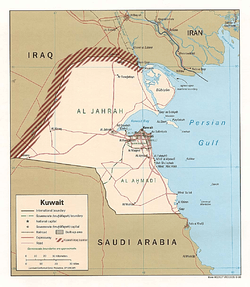Iraq–Kuwait barrier

The Iraq–Kuwait barrier (Arabic: حدود العراق-الكويت Hudud al-'Irāq-al-Kuwayt) is a 120-mile (190 km) border fence extending six miles (10 km) into Iraq, three miles (5 km) into Kuwait, and across the full length of their mutual border from Saudi Arabia to the Persian Gulf. Constructed by authorization of the United Nations Security Council, its stated purpose was to stop a re-invasion of Kuwait by Iraq.
The border barrier, made of electrified fencing and concertina wire, is braced by a 15-foot (4.6 m)-wide and 15-foot (4.6 m)-deep trench, complete with a 10-foot (3.0 m)-high dirt berm and guarded by hundreds of soldiers, several patrol boats, and helicopters. Construction of the barrier began in 1991.
In January 2004, Kuwait decided to install a new 217 km iron border barrier along the existing border. The stated needs were protecting the northern border, and preventing cars coming from Iraq from approaching the electricity bars.
The barrier will cost an estimated 28 million dollars and will extend from Umm Qasr until the joint border triangle where Saudi Arabia, Iraq, and Kuwait meet. Asphalted roads will be also constructed to facilitate border security movement.
Under Saddam Hussein's rule (until the Liberation of Kuwait in 1991) Iraq viewed Kuwait as part of Iraq, and viewed the barriers as illegally separating two parts of Iraqi territory.